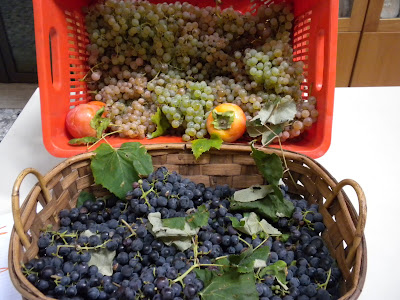
 A recently published book by David Farley, An Irreverent Curiosity: In Search of the Church's Strangest Relic in Italy's Oddest Town,
A recently published book by David Farley, An Irreverent Curiosity: In Search of the Church's Strangest Relic in Italy's Oddest Town, was a birthday present in September and the motivation to take an October weekend trip to
Calcata, about 45 km north of Rome. We did not arrive in the town until after dark, and had to walk in to the medieval strong hold after parking our car about .5 km away. We were greeted by a lively village just settling in for dinner. We found ourselves in the Grotta dei Germogli, a mosaic filled cave serving delicious food in an atmosphere filled with friends and folk music.

After dinner we enjoyed some time in the pizza listening to music (and dancing) until about midnight. We were able to get a very comfortable room for the night from Marijcke van der Maden, a Dutch puppet-maker, who came to Calcata in the early ’80s. We had cappuccino with her on Sunday morning and met some of the other "locals."

Before lunch we explored the narrow winding cobblestone streets. Calcata is actually a heavily fortified village, sitting atop of rock column. The only entrance into the town is by foot, and after entering the gate you ascend a winding passageway to the small piazza and town center. People say that it is one of the best preserved medieval towns in Italy.

The town was condemned by the goverment in the 1930s because it was deemed to be unsafe because of what could happen in future earthquakes danger, After many delays the inhabitants were moved in the 1960's to a new town about 1 km up the adjoining hill. In the late 1960's and 1970's bohemians (from Italy and around the world) started to inhabit the empty medieval structures and the town was reborn as an artists haven with restaurants and art galleries. (The new inhabitants even convinced the government that the assessment of earthquake danger was wrong.)


Today there are about 75 inhabitants in Calcata and it is a popular weekend destination for young Romans. There were probably 200 visitors wandering around the town on Sunday.



David Farley wrote about searching for the Church's strangest relic. The story goes that after the Sack of Rome in 1527, a German soldier, running away from Rome, ended up in Calcata with a relic he had stolen from San Giovanni Laterano. It was nothing less than the
Santo Prepucio, the foreskin of Jesus. But, the Holy Foreskin mysteriously disappeared 4 centuries later in 1983. (Marijcke told us that she had seen the reliquiry in processions when she first moved to Calcata and she suspects that the Vatican took it.)
















































